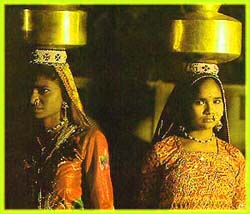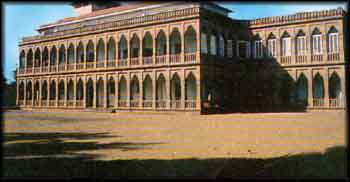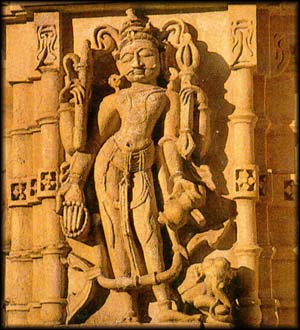| Destinations
|
|||
 The name has a musical ring. Saurashtra, literally a region of one hundred kingdoms. Undoubtedly, the past of this princely area is rich in antiquity and history, as it is in lores and legends. One of Gujarat's most picturesque regions, modern day settlements still pay homage to the glories of yesteryear. Here, there were glittering palaces with all the wealth of the world contained within. Here, there were temples and mosques, rich not only architecturally, but also in sheer wealth. Here, there were gardens and sparkling fountains, beautifully sculpted step-wells and imposing forts. And knitting them together is a warm people known for their hospitality, and for their love of art in daily life.
The name has a musical ring. Saurashtra, literally a region of one hundred kingdoms. Undoubtedly, the past of this princely area is rich in antiquity and history, as it is in lores and legends. One of Gujarat's most picturesque regions, modern day settlements still pay homage to the glories of yesteryear. Here, there were glittering palaces with all the wealth of the world contained within. Here, there were temples and mosques, rich not only architecturally, but also in sheer wealth. Here, there were gardens and sparkling fountains, beautifully sculpted step-wells and imposing forts. And knitting them together is a warm people known for their hospitality, and for their love of art in daily life. But while the past endures beautifully in the state, Gujarat has also moved with the times, and Saurashtra has played an important role in the pace of development that characterises many of its towns. Here is a blend of the finest meeting of centuries that is at once exciting and picturesque. |
More on Gujarat • Introduction • Saurashtra - Part II • Ahmedabad, Baroda • Gir Sanctuary
Travelogues
Leisure |
||
The plateau in central Saurashtra slopes towards the narrow coastal plains ending at sea-port settlements, while on the other side lie dense forests. The region attracts an average annual rainfall of 75 cms. Its inhabitants combine a martial past with maritime skills. Their love for colour and artistry has touched every aspect of their lifestyle, and the handicrafts of the region enjoy the patronage of all the states of India. Romantic literature has flowered in the region, as have religious texts. The wealth of the natural countryside has been the backdrop to it all. Saurashtra finds mention in ancient Indian epics and treatises, as well as in the writings of early travellers such as Ptolemy and Hieun Tsang.
Bhavnagar
An 18th century city, Bhavnagar was the capital of an erstwhile princely state. It's business today is vastly different, for it is a premier cotton-exporting sea-port on the south-eastern Saurashtra coast.
A Old books, manuscripts, rare coins, arms and armour used by the Bhavnagar rulers are on display at the Burton Library and Museum The more-scientifically inclined may enjoy their visit to the Central Salt and Marine Research Institute. The city is dotted with gardens that make it very pleasant if you should choose to stroll around in the evenings or mornings. On the outskirts of the city is Victoria Park, a 500-acre expanse that has been developed as a botanical garden, and has a deer park in it. On a hill overlooking the city below is Takhteshwar Temple devoted to the worship of Lord Shiva. Forty kilometres out of the city, at Vallabhipur is an ancient centre of learning. Also recommended are visits to the picnic spot of Gaurishankar Lake, adjacent to which is a well laid park and a planetarium. Bhavnagar also forms a convenient base for visits to Palitana and the scared hill of Shetrunjaya. How to Get There
Air: Connected with Bombay.
Where to Stay
Dwarka
Known in Puranic days as Kushasthali or Dwaravati, Dwarka on the west coast of Gujarat lies by the Arabian Sea and is the cradle of the Krishna legends. It is here that Lord Krishna is supposed to have ruled, and excavations have revealed that the present settlement is the sixth here, five others having been obliterated by the sea.
There are a very large number of temples in Dwarka of varying antiquity, most associated with some anecdote from the Puranas or the Mahabharata. One of the most popular temples is that of Rukmini, Krishna's wife, considered an incarnation of Lakshmi, the goddess of wealth and beauty.
The Sharad Peetha is one of the four Maths established by Jagatguru Shankaracharya.
The Puranas mention 12 Jyotirlingas or columns of light representing Lord Shiva that manifested itself in different parts of the country. The one located in Dwarka is known as Nageshwar Mahadev and is a popular place of pilgrimage.
The place where Lord Krishna is believed to have lived, Bet Dwarka is also sanctified as the place where Vishnu slew the demon Shankhasura.
Where to Stay
Jungadh Located at the base of Girnar Hill, Junagadh is the home of many legends which in turn have been responsible for the large number of shrines in the city.
The Fort of Uppar Kot is an imposing reminder of the city's medieval past. Within, are two wells called Adi-Kadi after the names of two girls. Another well, the Naughan has been dug to a great depth out of soft stone and has a very imposing staircase descending down to water-level. On the way to Girnar from the fort are the ancient Wagheswari temples and the Ashokan stone edicts with their 250 BC Pali inscriptions.
Visitors can go up Mount Girnar in dolis or chair lifts. On top of the hill are beautiful Jain temples. The biggest among them is Neminath, the shrine of the 22nd Jain teerthankara.
Another temple of significance is one dedicated to Goddess Amba. The adjoining hill of Datar has a Muslim shrine dedicated to Jaimal Shah Pir who is believed to have come from Sind at the behest of his preceptor, Pir Patta.
It is interesting to note the presence of Buddhist caves here.
Back in Junagadh, there is the Silehkhana and Darbar Hall, the armoury and the audience hall, both containing the royal regalia of former days, along with ancient weapons. The Sakerbag garden comprises of a small zoo, its proudest inhabitants being the Asiatic lions from the Gir forests.
Where to Stay
Palitana This is one of India's most picturesque pilgrim centres. Located on Shetrunjaya hill are 863 temples built over an impressive span of nine hundred years. The temples are exquisitely carved in marble, veritable prayers in stone. To an observer, these appear to be ivory miniatures when seen from a distance.
Created by master craftsmen, the most important temple is that of the first teerthankara, Shri Adishwar. It has ornate architectural motifs, though in its overall plan it is simpler than the Choumukh. Other notable temples are those of Kumarpal, Vimalshah and Sampriti Raja. The earliest temple was probably built by Kumarpal Solanki, a great Jain patron. The temple has a fabulous collection of jewels, and these can be seen with special permission.
How to Get There A small port town that is linked with India's history through its association with Mahatma Gandhi who was born here. The ancestral Gandhi house where Gandhi was born was purchased by the family in the 18th century, and the Mahatma's father was the hereditary Dewan of Rajkot. The home of Gandhi's childhood is now open to visitors. Known by the name of Kirti Mandir, it contains a Gandhian library, his personal effects, a photo-exhibition on his life and times, a hall for spinning cotton thread and a prayer hall. Porbandar is also the place where Gandhi's wife, Kasturba, was born. A chronological history on the life of the Mahatma is listed here.
Porbandar, in olden days, had a flourishing trade with Arabia, Africa and the Persian Gulf. It was then known as Sudamapuri in the memory of Lord Krishna's friend, and there is a temple dedicated to Sudama here.
Among institutions worth paying a visit are the Arya Kanya Gurukul and Bharat Smriti. The planetarium nearby is a great attraction. Porbandar today is also an industrial town with cement and chemical units. It has a fine beach and beautiful villas on the seacoast.
How to Get There
Where to Stay The home of the Asiatic Lion, and its retreat, Sasan Gir is a wildlife sanctuary for the protection of this rare species, and other animal and bird life.
Sasan Gir is one of the country's largest wildlife parks with a core area that spreads over 258.71 sq km. According to the 1989 census, the lion population in the park is 255.
The forest also harbours a variety of other animals and birds, including predators such as the panther and the hyena. The deer family is adequately represented by sambar, chital, chousinga, nilgai and chinkara. Also found are the bear and long-tailed langur. The peacock is the most commonly seen bird here. A crocodile farm has been developed within the sanctuary. The park is open from mid-October to mid-June.
How to Get There
Information: Courtesy Government of India
|
|||
Editor: Romola Butalia (c) India Travelogue. All rights reserved. |
|||
 mong its many attractions is Samaldas College, just over a hundred years old, a frontline institution that claims Mahatma Gandhi as one of its students. In fact, Bhavnagar treasures its association with the Mahatma and at Gandhi Smriti a memorial to him has been constructed that consists of a very fine library with a museum of photographs depicting every facet of Bapu's life. Gandhi Smriti aims at keeping Gandhian thought alive, and to this end it also houses a Khadi Gramodyog Bhandar for the sale of hand-spun, cotton khadi cloth.
mong its many attractions is Samaldas College, just over a hundred years old, a frontline institution that claims Mahatma Gandhi as one of its students. In fact, Bhavnagar treasures its association with the Mahatma and at Gandhi Smriti a memorial to him has been constructed that consists of a very fine library with a museum of photographs depicting every facet of Bapu's life. Gandhi Smriti aims at keeping Gandhian thought alive, and to this end it also houses a Khadi Gramodyog Bhandar for the sale of hand-spun, cotton khadi cloth.

 Jagat Mandir or Nij Mandir forms the sanctum of Dwarkadish temple and dates back to 2500 years. Jagat Mandir has its own hall of audience and a conical spire. The roof of the hall is supported by 60 columns and the main temple rises five storeys high. The spire rises to a height of 157 feet and is richly carved.
Jagat Mandir or Nij Mandir forms the sanctum of Dwarkadish temple and dates back to 2500 years. Jagat Mandir has its own hall of audience and a conical spire. The roof of the hall is supported by 60 columns and the main temple rises five storeys high. The spire rises to a height of 157 feet and is richly carved.